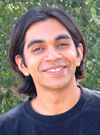
http://www.umn.edu/urelate
612-624-6868
Spring 2014
Tuesdays, 11:45 to 12:45
Elliott S204
 Jan. 21 - Neuroexistentialism - Roger Dumas
Jan. 21 - Neuroexistentialism - Roger Dumas
Churchland, P. S. (2013). Touching a Nerve: The Self as Brain (p. 304). W. W. Norton & Company. Ch. 4 "The Brains Behind Morality" 83:103
 Jan. 28 - Spatial Cognition (broadly) - Sofia Sakellaridi
Jan. 28 - Spatial Cognition (broadly) - Sofia Sakellaridi
Landau, B., Gleitman, H., & Spelke, E. (1981). Spatial knowledge and geometric representation in a child blind from birth. Science (New York, N.Y.), 213(4513), 1275-1278.
 Feb. 4 - Spatial Cognition - Apostolos Georgopoulos
Feb. 4 - Spatial Cognition - Apostolos Georgopoulos
Georgopoulos A (2000) Neural Mechanisms of Motor Cognitive Processes: Functional MRI and Neurophysiological Studies, in The New Cognitive Neurosciences, 2nd ed., Gazzaniga M (editor) MIT Press (Cambridge, MA) 525-538
Feb. 11 - Probability Theory - Michelle Wang
Nowak AN & Krakauer DC (1999) The evolution of language. Proc. Natl. Acad. Sci. 96 8028:8033
 Feb. 18 - Philosophy of Cognitive Science - Nicole Scott
Feb. 18 - Philosophy of Cognitive Science - Nicole Scott
Colapietro V, The space of signs: C.S. Peirce's critique of psychologism,
Feb. 25 - Irrationality & Belief - Roberto de Freitas
Marsella S & Gratch J (2002) A step toward irrationality: using emotion to change belief. First International Joint Conference on Autonomous Agents and Multiagent Systems, Bologna, Italy
 Mar. 4 - Language & Cognition - Jeanette Gundel
Mar. 4 - Language & Cognition - Jeanette Gundel
Chomsky N (1975) Reflections on Language. Pantheon, Ch 4,
 Mar. 11 - "Agile Minds/Agile Organizations: A Thinking Framework for Creativity and Change" - Wilma Koutstaal
Mar. 11 - "Agile Minds/Agile Organizations: A Thinking Framework for Creativity and Change" - Wilma Koutstaal
Mar. 18 - Spring Break
 Mar. 25 - Embodiment - Thomas Stoffregen, Kinesiology
Mar. 25 - Embodiment - Thomas Stoffregen, Kinesiology
Wilson A & Golonka S (2013) Embodied cognition is not what you think it is. Frontiers in Psychology, 4, article 58 (467kb)
 Apr. 1 - Cognitive Psychopathology - Nicole Scott, Graduate Program in Cognitive Science
Apr. 1 - Cognitive Psychopathology - Nicole Scott, Graduate Program in Cognitive Science
Scott N (in press) Female intrasexual competition in primates: why humans aren't as progressive as we think. In Women in Competition, Oxford Handbook.
April 8 - Decision-making - Thomas Christie, Graduate Program in Cognitive Science
Gershman SJ, Markman AB & Otto AR (2012) Retrospective Revaluation in Sequential Decision Making: A Tale of Two Systems. J Exp Psych v143(1):182-94
 April 15 - Video Games - Windy Torgerud, Graduate Program in Cognitive Science
April 15 - Video Games - Windy Torgerud, Graduate Program in Cognitive Science
Bavelier D, et al. (2012) "Brain plasticity through the life span: Learning to learn and action video games" Annu. Rev. Neurosci 35:391–416 (712kb pdf)
The ability of the human brain to learn is exceptional. Yet, learning is typically quite specific to the exact task used during training, a limiting factor for practical applications such as rehabilitation, workforce training, or education. The possibility of identifying training regimens that have a broad enough impact to transfer to a variety of tasks is thus highly appealing. This work reviews how complex training environments such as action video game play may actually foster brain plasticity and learning. This enhanced learning capacity, termed learning to learn, is considered in light of its computational requirements and putative neural mechanisms.
 Apr. 22 - Play & Creativity - Michael Maratsos
Apr. 22 - Play & Creativity - Michael Maratsos
Carlson, Stephanie M., Taylor, Marjorie, Levin, Gerald R (1998) The influence of culture on pretend play: the case of Mennonite children. Merrill-Palmer Quarterly, Vol. 44, Issue 4
 Apr. 29 - Mindfulness & Meditation - Sucharit Katyal
Apr. 29 - Mindfulness & Meditation - Sucharit Katyal
"What is Dharma?" from the book, "Ananda Marga: Elementary Philosophy" by Shrii Shrii Anandamurt (216kb pdf)
Dharma PrefaceOver the past few decades, there has been a growing interest in studying the effects of mental training using meditation techniques inspired by contemplative practices from various spiritual traditions such as Buddhism, Yoga etc. Such mental training has been shown to positively affect a variety of psychological measures in both clinical (for review see, McGee, Psychiatry, 2008) and non-clinical populations (for review see, Sedlmeier et al, Psych Bulletin 2012). Accompanying these psychological changes, the meditation techniques are also shown to be correlated with changes in neural response patterns (for reviews see Cahn and Polich, 2006), anatomy such as gray matter volume (Luders et al, Neuroimage, 2009), and a host of other psychobiological measures.
With effects of meditation being demonstrated on such a wide range of psychological and physiological factor there isn’t yet a single unified model about the mechanism of meditation (Sedlmeier et al, 2012). In recent years (Walsh & Shapiro, 2006; Sedlmeier et al, 2012) it has been suggested that the lack of a clear understanding of the effects of meditation on the mind may have to do with how findings from these studies have been interpreted within a purely Western psychological framework.
It has also been suggested that questions that have so far been investigated using these practices have arisen from within such a framework, i.e. looking at psychotherapeutic effects or performance enhancement on tasks, and have likely missed some of the other goals for which these practices were developed and perfected for.
It has also been suggested that it may be beneficial to look at the philosophical and psychological frameworks from the traditions themselves to form a more holistic and overarching understanding of the human mind. What the traditional psychologies and philosophies may help provide is an alternative way to look at human cognition, attention and emotion (Rosch, Psych Sci, 2009). This may help in human psychology becoming more inclusive as it is able to incorporate an aspect of phenomenological human experience from the perspective of long-term meditation practitioners who report inducing certain transpersonal states of consciousness different from the regular and mundane awake, asleep and dream states of consciousness.
As an example, it is reported across various contemplative traditions that after years of practice when attention is controlled and can be unwaveringly focused on a single point or object, there is a experience of self-transcendence that occurs, which leads to a state of a ‘fourth’ state of consciousness (called turiya in the Yogic tradition). The mind in such a state stays absorbed in itself rather than constantly jumping and following its attention around from object to object, and is described as lasting peace or bliss.
The following book chapter (What is Dharma?; dharma means innate nature characteristic of an entity) is taken from the book Ananda Marga: Elementary Philosophy, written in 1955 by a Yogic master Shrii Shrii Anandamurti, , which describes the Yogic perspective on the psychology of meditation. The first half describes their view on why one seeks meditates (with the goal of ‘enlightenment’) and second half describes cognition and its relationship with mind and consciousness within the Yoga psychology framework.
 May 6 - Mirror System - Trent Jerde
May 6 - Mirror System - Trent Jerde
Rizzolatti, G., Fogassi, L., B, P. T. R. S., Rizzolatti, G., & Fogassi, L. (2014). The mirror mechanism : recent findings and perspectives. Phil. Trans. R. Soc. B, 369(April).

